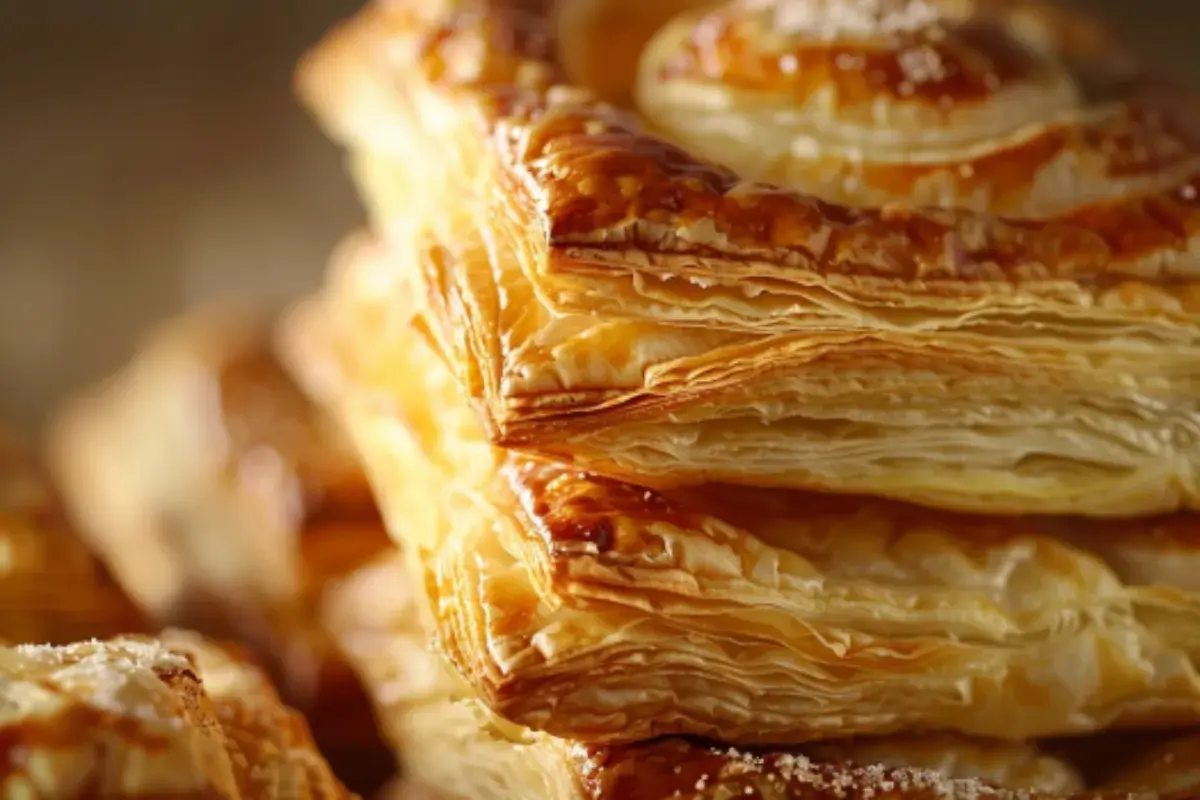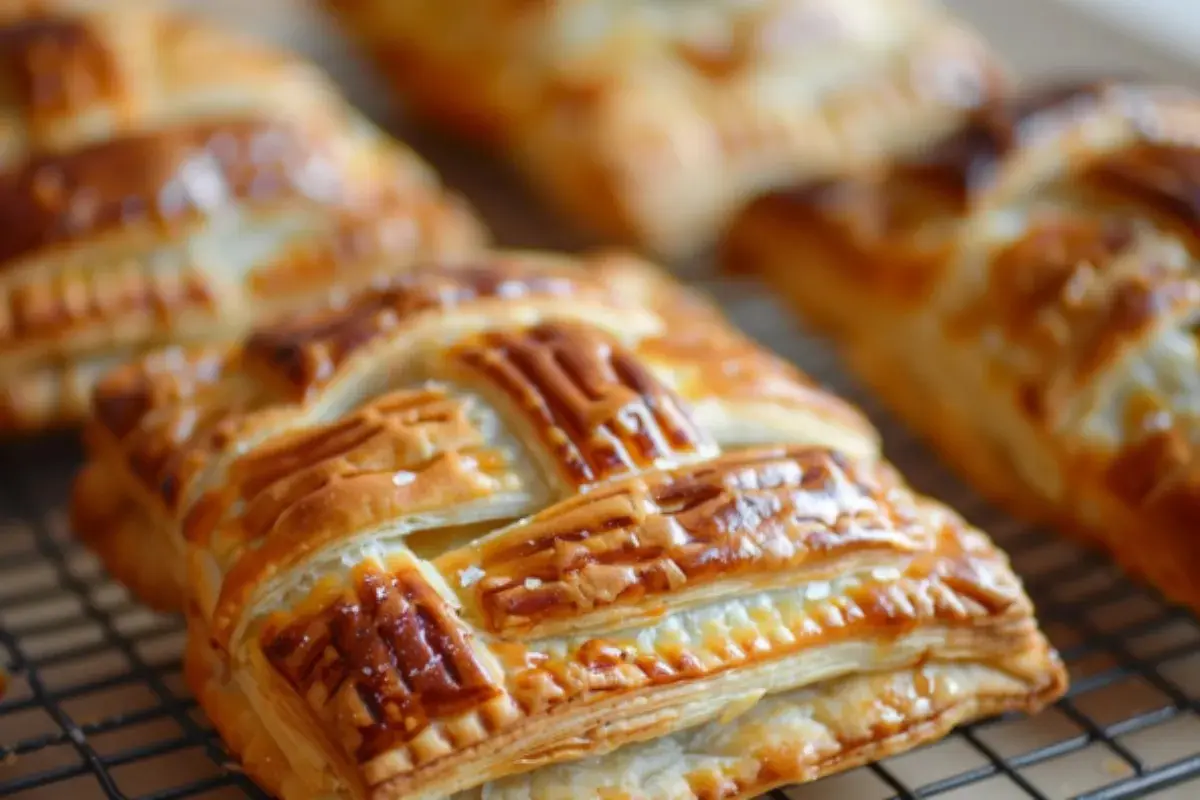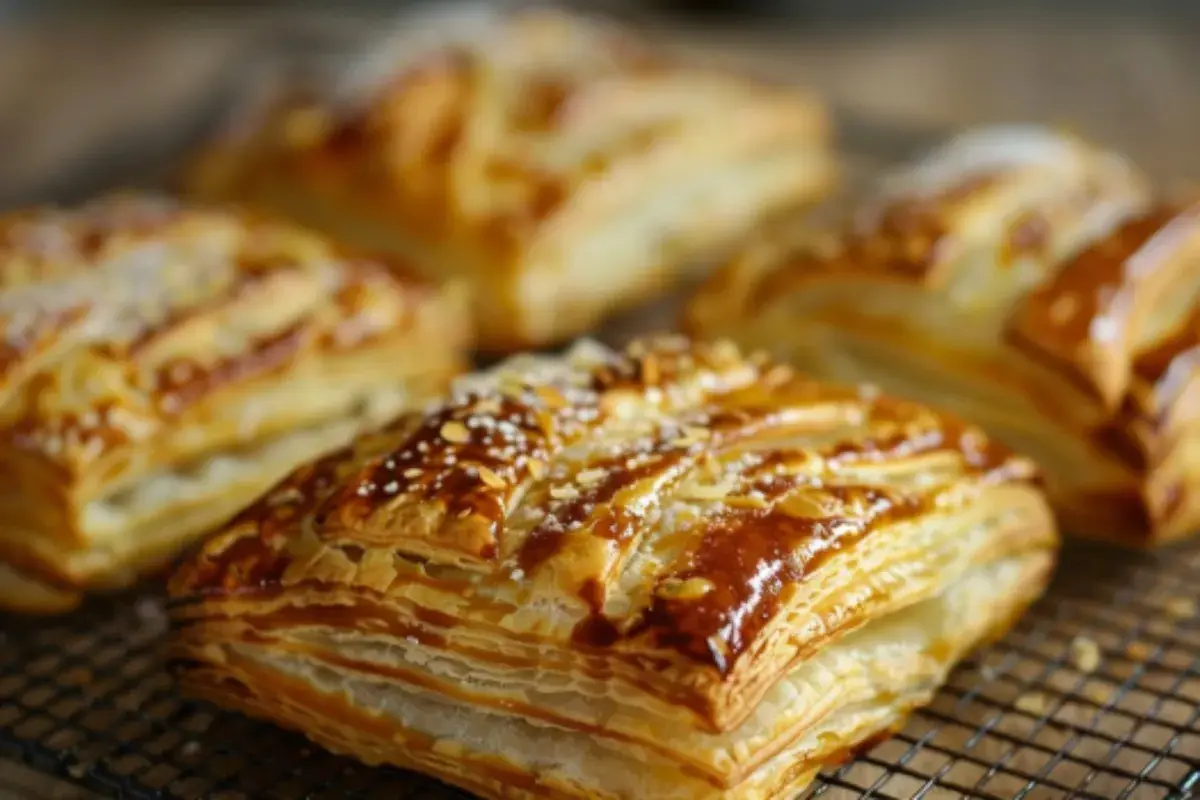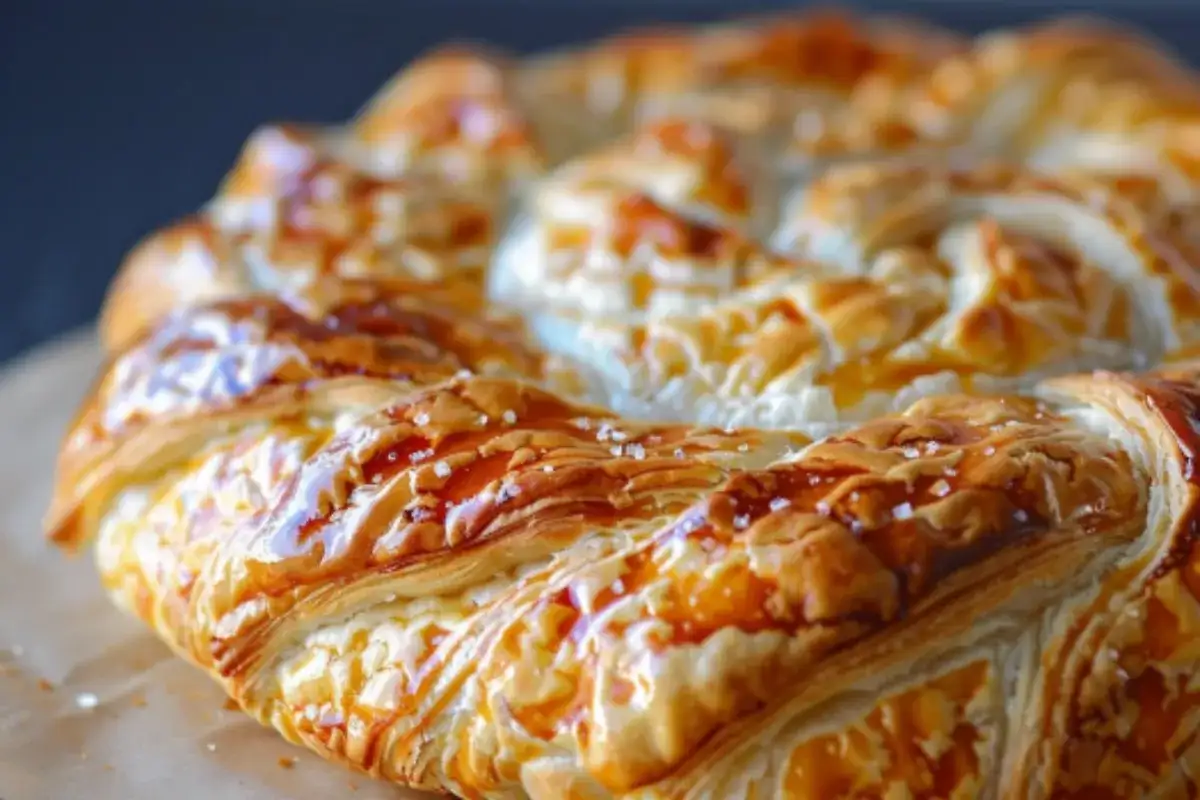Puff pastry is one of the most versatile and rewarding ingredients in the world of baking. Whether you’re crafting a savory appetizer, a flaky dessert, or even an impressive main dish, puff pastry recipes can elevate your creations to new heights. Its delicate, buttery layers add a rich texture to both sweet and savory dishes, making it a favorite for bakers of all skill levels. In this comprehensive guide, we’ll explore everything you need to know about working with puff pastry, from the basics of making it from scratch to discovering exciting recipe ideas.
What is Puff Pastry?
At its core, puff pastry is a laminated dough, made by repeatedly folding and rolling layers of butter into the dough. When it bakes, the butter melts, releasing steam that causes the dough to puff up, creating its signature flaky layers. Originating in France, puff pastry has been a staple of European bakeries for centuries and has since become a beloved ingredient worldwide.
There are many reasons to love puff pastry. Its versatility allows it to be used in a wide variety of dishes, from the simplest turnovers to more complex creations like Beef Wellington or Tarte Tatin. Whether you’re using it as a base for tarts, pies, or savory appetizers, puff pastry offers endless culinary possibilities.
Why Use Puff Pastry?

Puff pastry’s biggest appeal lies in its ability to create a light, crispy texture that enhances any dish. When baked, the butter trapped within the dough evaporates, creating air pockets that lead to the formation of its delicate, flaky layers. Puff pastry is ideal for both beginner and experienced bakers because of its versatility and the sheer variety of dishes you can create.
Key Benefits of Puff Pastry:
- Versatility: Puff pastry can be used for both sweet and savory dishes.
- Time-Saving: While making puff pastry from scratch is rewarding, store-bought puff pastry is a convenient alternative that delivers fantastic results.
- Elegant Presentation: The delicate layers of puff pastry give your dishes a professional, bakery-worthy look.
If you’re new to working with puff pastry, you may want to try using pre-made frozen puff pastry as a starting point. Brands like Pepperidge Farm and Dufour offer frozen puff pastry sheets that can be used in a variety of recipes. However, if you’re feeling adventurous, you can also make your own from scratch, following this homemade puff pastry recipe.
For those who are short on time, the rough puff pastry method is an excellent alternative, producing a flaky result in a fraction of the time it takes to make traditional puff pastry.
How to Make Puff Pastry from Scratch
Making puff pastry from scratch requires patience and precision, but the result is a beautifully flaky dough that will take your dishes to the next level. Puff pastry is made through a process called “lamination,” in which layers of butter are encased in dough and repeatedly rolled and folded. While it may seem intimidating at first, mastering puff pastry can be incredibly rewarding.
Ingredients for Classic Puff Pastry:
- Flour: All-purpose flour works well, but pastry flour can also be used for a more delicate texture.
- Butter: High-quality, cold butter is key. The colder, the better, as it helps create the layers.
- Water: Cold water is essential for keeping the butter from melting too quickly during the folding process.
- Salt: Just a pinch to enhance the flavor of the dough.
Step-by-Step Instructions:
- Make the Dough (Detrempe): Combine the flour, salt, and cold water to form a dough. Knead it gently until smooth, then shape it into a disc and chill for at least 30 minutes.
- Prepare the Butter (Beurrage): Place your cold butter between two sheets of parchment paper and use a rolling pin to flatten it into a square. The butter should be cold but pliable.
- Laminate the Dough: Roll out the dough into a large rectangle. Place the butter in the center, then fold the dough over the butter like an envelope. This is the start of your layers.
- Roll and Fold: Roll the dough into a long rectangle, then fold it into thirds (like folding a letter). This is called a “turn.” Chill the dough for 30 minutes between each turn. Repeat this process 6 times to achieve the multiple layers that make puff pastry so flaky.
- Chill and Use: After the final turn, chill the dough for at least an hour before using it in your recipe.
While the traditional method takes time, the end result is worth it. If you’re pressed for time, consider trying the rough puff pastry method, which produces a similar flaky texture in a shorter amount of time.
Rough Puff Pastry
Rough puff pastry is a quicker, more approachable version of the classic method. Instead of layering the butter between the dough, you incorporate chunks of cold butter into the dough and then roll and fold it a few times to create the layers. The result is still a beautifully flaky pastry, but with less time and effort.
- Ingredients:
- All-purpose flour
- Cold butter, cut into cubes
- Cold water
- Salt
- Steps:
- Mix the flour, salt, and cubed butter together, leaving the butter in large chunks.
- Add cold water and form a dough. The butter chunks should still be visible.
- Roll and fold the dough a few times, chilling between turns, to create the layers.
Rough puff pastry is ideal for recipes like fruit tarts and cheese sticks where the focus is more on flavor and texture rather than presentation.
Sweet Puff Pastry Recipes

One of the most popular uses for puff pastry is in creating elegant, flaky desserts. Whether you’re making a simple turnover or a show-stopping tart, puff pastry provides the perfect base for a wide range of sweet treats.
Fruit Tarts
Puff pastry fruit tarts are both easy and visually impressive. The puff pastry creates a light and crispy crust that pairs beautifully with fresh fruit and cream. For an extra touch of sweetness, you can brush the pastry with a glaze made from apricot preserves before baking.
- Ingredients:
- Puff pastry sheets
- Cream cheese or pastry cream
- Fresh fruit (strawberries, blueberries, peaches, etc.)
- Apricot preserves (for glaze)
- Steps:
- Roll out the puff pastry and cut it into circles or squares, depending on your desired shape.
- Spread a layer of cream cheese or pastry cream in the center, leaving a border around the edges.
- Arrange sliced fresh fruit on top.
- Brush the edges with beaten egg and bake until golden and puffed.
- After baking, brush the fruit with warm apricot preserves to add shine.
Apple Tarte Tatin
The apple tarte tatin is a classic French dessert that’s perfect for showcasing puff pastry. The dish is made by caramelizing apples in butter and sugar, then covering them with puff pastry and baking. Once it’s done, you flip the tart over, revealing beautifully caramelized apples sitting atop a golden, flaky crust.
- Ingredients:
- Puff pastry
- Apples (Granny Smith or Honeycrisp work well)
- Butter
- Sugar
- Steps:
- In an oven-safe skillet, cook butter and sugar until it forms a caramel.
- Arrange sliced apples in the caramel, then cover with puff pastry.
- Bake until the pastry is golden brown and puffed.
- Carefully flip the tart onto a serving plate so the apples are on top.
Chocolate-Filled Pastry Bites
For a quick and easy dessert, try making chocolate-filled pastry bites. These bite-sized treats are made by filling squares of puff pastry with a piece of chocolate, folding them over, and baking. Serve them warm for a gooey, melty chocolate center.
- Ingredients:
- Puff pastry
- Dark or milk chocolate
- Egg (for egg wash)
- Steps:
- Cut puff pastry into small squares.
- Place a piece of chocolate in the center of each square.
- Fold the pastry over and seal the edges.
- Brush with egg wash and bake until golden brown.
Savory Puff Pastry Recipes
While puff pastry is often associated with sweet dishes, it’s equally at home in savory recipes. The buttery, flaky dough adds richness and texture to appetizers, snacks, and even main courses. Here are a few savory puff pastry recipes to try.
Spinach and Cheese Swirls
These spinach and cheese swirls are a crowd-pleasing appetizer that’s easy to make and packed with flavor. Simply roll puff pastry with a mixture of spinach, cheese, and herbs, then slice into pinwheels and bake.
- Ingredients:
- Puff pastry
- Fresh spinach (cooked and drained)
- Cheese (cheddar, feta, or ricotta)
- Garlic and herbs
- Steps:
- Roll out the puff pastry and spread the spinach and cheese mixture over the surface.
- Roll the pastry into a log, then slice into pinwheels.
- Place the pinwheels on a baking sheet and bake until golden and puffed.
Puff Pastry Chicken Pot Pie
Puff pastry makes an excellent crust for savory pot pies. This chicken pot pie recipe uses puff pastry to create a flaky, golden topping for a creamy chicken and vegetable filling.
- Ingredients:
- Puff pastry
- Cooked chicken (shredded or diced)
- Mixed vegetables (carrots, peas, onions)
- Cream sauce (made with butter, flour, and chicken stock)
- Steps:
- Prepare the filling by cooking the vegetables and chicken in a creamy sauce.
- Pour the filling into individual ramekins or a large baking dish.
- Cover with puff pastry and bake until the crust is golden and puffed.
For more ideas on using puff pastry in savory dishes, you might also enjoy rotisserie chicken recipes, which pair perfectly with puff pastry to create hearty, satisfying meals.
Brie and Honey Puff Pastry Bites
These elegant brie and honey puff pastry bites make for a sophisticated appetizer. The buttery puff pastry pairs perfectly with the creamy brie and the sweetness of honey. Add a sprinkle of chopped walnuts or pecans for extra texture.
- Ingredients:
- Puff pastry
- Brie cheese
- Honey
- Chopped nuts (optional)
- Steps:
- Cut the puff pastry into small squares and place a piece of brie in the center.
- Drizzle with honey and top with chopped nuts.
- Fold the edges of the pastry over the filling and bake until golden.
Tips and Tricks for Working with Puff Pastry

Puff pastry is a fantastic ingredient, but it requires a bit of technique to work with effectively. Here are some tips to help you get the best results when using puff pastry.
Thawing Frozen Puff Pastry
If you’re using frozen puff pastry, it’s important to thaw it properly before use. Thaw the pastry in the refrigerator for several hours or overnight to ensure that it softens evenly. Avoid thawing puff pastry at room temperature, as this can cause the dough to become too soft and difficult to work with.
Keeping the Dough Cold
One of the most important factors when working with puff pastry is keeping the dough cold. If the butter within the dough gets too warm, it will begin to melt, which can result in greasy, dense pastry instead of the light, flaky layers you’re aiming for. If your dough becomes too soft while you’re working with it, simply return it to the refrigerator for 15-20 minutes to firm up before continuing.
Baking at High Temperature
Puff pastry needs a hot oven to create steam and puff up the layers. Preheat your oven to at least 400°F (200°C) before baking, and bake your puff pastry on the middle rack to ensure even browning. Avoid opening the oven door during baking, as this can cause the pastry to collapse.
Docking the Dough
If you’re making a recipe where you don’t want the puff pastry to rise too much (such as a tart base), you can “dock” the dough by pricking it all over with a fork. This allows steam to escape, preventing the dough from puffing up too much.
Egg Wash for Golden Color
For a shiny, golden finish, brush your puff pastry with a beaten egg before baking. This egg wash gives the pastry a beautiful color and adds a touch of richness.
Frequently Asked Questions About Puff Pastry
1. Can Puff Pastry Be Made Without Butter?
Yes, puff pastry can be made without butter, although the result will be slightly different. You can substitute margarine or a plant-based butter alternative for a vegan or dairy-free version of puff pastry. However, butter provides the best flavor and texture, so it’s the preferred fat for making puff pastry.
2. What is the Difference Between Puff Pastry and Phyllo Dough?
While both puff pastry and phyllo dough are used to create light, flaky layers, they are quite different. Puff pastry is made by laminating layers of dough and butter, which puff up when baked, creating thick, flaky layers. Phyllo dough, on the other hand, is made by stacking many thin layers of dough, resulting in a crisp, delicate pastry. Phyllo dough is commonly used in Mediterranean dishes like baklava and spanakopita, while puff pastry is used in a variety of European-style dishes.
3. How Long Can I Store Puff Pastry in the Freezer?
Frozen puff pastry can be stored in the freezer for up to six months. If you’ve made your own puff pastry from scratch, you can also freeze it for future use. Be sure to wrap the dough tightly in plastic wrap and then place it in a freezer bag to prevent freezer burn. When you’re ready to use it, thaw the dough in the refrigerator overnight.
4. Why Didn’t My Puff Pastry Puff Up?
If your puff pastry didn’t puff up as expected, there could be several reasons for this:
- The dough wasn’t kept cold: If the dough became too warm before baking, the butter may have melted before the pastry had a chance to puff.
- The oven wasn’t hot enough: Puff pastry needs a hot oven (around 400°F) to create the steam that causes the dough to puff up.
- The layers weren’t properly folded: Puff pastry relies on the layering of dough and butter. If the dough wasn’t folded correctly, the layers may not have developed.
5. Can Puff Pastry Be Reheated?
Yes, puff pastry can be reheated, although it’s best to do so in an oven rather than a microwave to preserve the crispness of the layers. Reheat puff pastry in a preheated 350°F oven for about 10 minutes, or until heated through. Avoid microwaving puff pastry, as it can become soggy.
6. How Do You Store Leftover Puff Pastry?
Leftover puff pastry can be wrapped tightly in plastic wrap and stored in the refrigerator for up to 2-3 days. If you won’t be using the pastry within that time, it’s best to freeze it to extend its shelf life. When storing baked puff pastry, let it cool completely before wrapping and refrigerating. Reheat it in the oven before serving to restore its crispness.
7. Can You Freeze Baked Puff Pastry?
Yes, baked puff pastry can be frozen. Allow it to cool completely, then wrap it tightly in plastic wrap and place it in a freezer-safe bag or container. Baked puff pastry can be frozen for up to 1-2 months. To reheat, bake the frozen pastry in a preheated 350°F oven for about 10-15 minutes, or until heated through and crispy.
Conclusion
Puff pastry is a truly versatile ingredient that can elevate any dish, whether sweet or savory. From elegant fruit tarts to hearty pot pies, puff pastry’s light, flaky layers add a touch of luxury to your cooking. With the tips, recipes, and techniques in this guide, you’re ready to take your puff pastry creations to the next level.
Explore more creative ways to incorporate puff pastry into your meals by checking out these ground beef recipe ideas, which pair wonderfully with flaky pastry to create delicious, satisfying dishes.
Whether you’re preparing a simple appetizer or an impressive dessert, puff pastry will always deliver a show-stopping result. So go ahead, grab some puff pastry (or make your own), and start baking!

